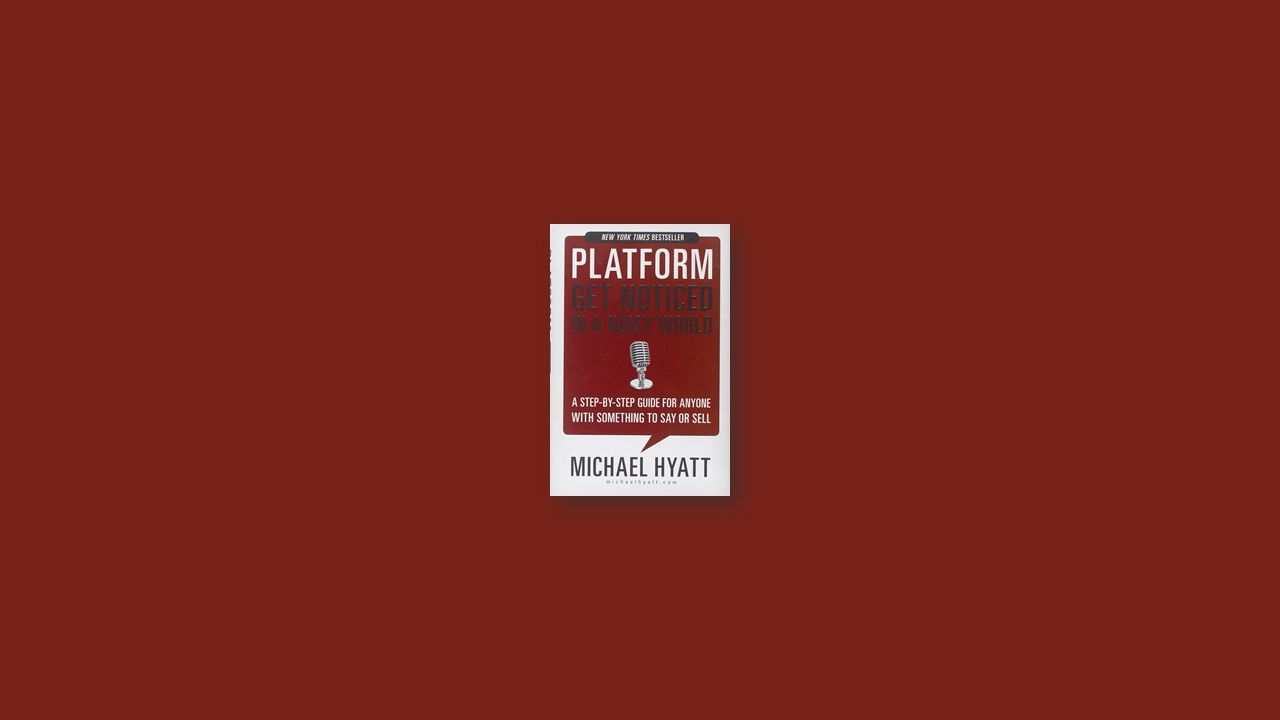More than four centuries ago, William Shakespeare wrote, “All the world’s a stage,” and his words are truer today than ever before. If you have something to say—through a blog, a seminar, a book, a song, a screenplay, a sermon, or a stage play—you are on stage. If you have something to sell—whether one-on-one, before a huge crowd, or on the Internet—you are also on stage.
But the stage has never been more crowded—and simply being on it doesn’t matter much if the lights are not shining on you, or if there is no one in the audience.
This book is all about attracting that audience, turning on the brightest lights you can find, and building passionate loyalty so your audience stays with you through every line, every scene, every act. It’s not about ego or being the center of attention. It is about having something of value to others and finding the most powerful way of getting that message to others who can benefit from it.
#1 Wrap the Wow in Style
While people shouldn’t judge a book or any other product by its cover, they do. This is why it is so critical that you spend the time and money to get the packaging on your product right. It doesn’t matter if it’s a dog toy, a clothing line, a book, or a record album. People will never get to experience your brilliance unless the packaging gets them to pick it up and explore it.
With this perspective, here are ten tips for developing eye-popping packaging and thus increasing your chances of sales success:
- Know your audience.
The point is that it’s not about you. It’s about your audience. What would they find compelling?
- Consider your brand.
While the audience is important, so is your brand. You have to strike a balance between reaching your audience and representing who you are—or want to become. This means paying close attention to fonts, colors, and even textures and materials. All of them communicate subtle messages about your brand.
- Review the best-seller lists.
It is worth taking a look at the best sellers in your product category. What current design trends do you see? What seems to be working? Review the top one hundred products and take notes.
- Make the investment necessary
You won’t get a second chance to make a first impression. If your packaging looks cheap, dated, or confusing, your prospective customers will assume that your actual product is (surprise!) cheap, dated, or confusing. Therefore, you need to invest in the best designer you can afford. Don’t try to do it yourself to save money (unless you are actually a designer). Remember, there is nothing more expensive than a cheap design that doesn’t work.
- Don’t provide too much direction—at least initially.
Don’t limit the imagination of your designers. If you do, you won’t get their best work. Instead, describe your product and the audience. Then get out of the way and see what they come up with.
- Insist on several comps.
Tell designers up front that you will want to see several comps (short for “comprehensive layouts”). You want to be able to pick and choose from various alternatives.
- Be careful with design metaphors.
If you use a design metaphor, make sure the connection to the product is obvious. Think about all the messages it communicates.
- Don’t let the design get in the way.
Be especially wary of designs that require an explanation for you to “get it.” Your prospective customers won’t have the benefit of someone standing next to them in the store or online explaining what it means.
- Evaluate the packaging in context.
Once you are close to a final design, you need to evaluate it in the various merchandising environments in which your product will appear. For example, will the packaging “pop” on a shelf with similar items? Is the type readable from five feet away? What about ten? What about the online context? How will it look when it is reduced to 260 pixels high on an online retailer site? Don’t get married to a design until you have seen the product in the appropriate environments.
- Ask your fans.
If you already have a blog, Twitter, or Facebook following, you can test various design options with your best prospects—the people who already want to hear what you have to say.
#2 Think Bigger . . . No, Bigger!
While you are preparing to launch, consider your mental attitude. If you’re going to be the chief marketing officer for your wow product, you must think bigger than you ever have before.
Here are seven steps to thinking big:
- Imagine the possibilities.
Give yourself permission to dream.
- Write down your dream.
This is the act that transforms a dream into a goal. Wonderful things happen when you commit something to writing.
- Connect with what is at stake.
This is your rationale. Unfortunately, it is a crucial step that people often omit. Before you can find your way, you must discover your why. Why is this goal important to you?
- Outline what would have to be true.
Rather than merely asking how to get from where you are to where you want to go (strategy), I like asking what would have to be true for my dream to become a reality.
- Decide what you can do to affect the outcome.
This is where you transition from the big picture to daily actions. This is where people often get derailed. They can’t see all the steps that will take them to their goal. So rather than doing something, they do nothing. You will never see the full path. The important thing is to do the next right thing. What can you do today to move you toward your dream?
- Determine when this will happen.
Someone once said a goal is simply a dream with a deadline. A deadline is one way to make the dream more concrete—which is exactly what thinking big is about. A deadline also creates a sense of urgency that will motivate you to take action.
- Review your goals daily.
Don’t listen to that mocking little voice that tells you to be more realistic. Ignore it. You can either accept reality as it is or create it as you wish it to be. This is the essence of dreaming—and thinking big.
#3 Create the Content Yourself
Forget the fact that blogging is more than a decade old and Twitter is already a mature medium. Now that these and other social media have gone mainstream, no one wants to be left behind. Everyone is jumping on board.
What some of these new converts don’t understand is that social media only works well if the communication is personal, authentic, and near immediate. Here’s what I mean:
- Personal.
Even if people don’t know you, they can tell if you are the one writing. You might be able to fool them for a while, but blogging and tweeting require you to express your personality. If you don’t, readers sense that something is not quite right.
- Authentic.
People will only trust you if you are willing to pull back the curtain of your life and give them a peek inside. Of course, this is helpful in every form of communication. It connects people in a powerful way. But it is essential with blogging and tweeting. You must be willing to share yourself.
- Immediate.
Blogging and tweeting are a dialogue. You get to introduce the topic and may even moderate it, but you are expected to participate in the ongoing conversation. As a result, you must respond to some blog comments and most Twitter replies and direct messages.
All of this requires your personal participation. You can’t hire it done. You can’t fake it. If you’re not willing to.
#4 Employ Consistent Branding
Let’s assume that you are serious about starting a blog (a key to building your platform), so to support your blog and get your name out, you are going to develop pages on Twitter, Facebook, and YouTube. Are you content to upload your photo to all of them individually and be done with it? Or do you want a more consistent brand image, one that ties it all together?
Whether you design your own pages, or have them designed for you, here are four elements you want to include on a consistent basis across all platforms:
- Your Name.
Use it in exactly the same form in every instance.
- Your Logo.
It could also be a type font that is associated with your name.
- An Avatar.
Have your portrait done by a professional photographer, and use the same one in every application. Close-ups are best. If you are a public speaker, you may want to use an action shot.
- A Branding Statement.
This could be a slogan, a sell-line, or even the name of the product or service for which you are known—or would like to be known.
A consistent brand is vital for a strong platform. It’s something I’ve worked hard to develop, and it should be one of your top priorities.
#5 Monitor Your Brand
Whether you like it or not, people are talking about you, your brand, or your organization online. Right now. Do you know what they are saying? Do you like what they are saying?
Here are the specific actions that you, as an individual or organization, can take to monitor your brand online:
- Sign up for Google Alerts
It’s fast and super easy. Best of all, it’s free. Once you do so, you can enter the names of those you want to monitor. I suggest you start with the following:
Your personal name and its variations; the names of your key executives; the name of your company or organization; the names of your more important brands, products, or services; and the names of your key competitors.
Now decide how you want to be notified. You can choose either email or RSS feed.
- Use Twitter search.
You can use this handy little tool to also monitor for the same names you used with Google Alerts. You can then save the search for reusing or bookmark the search results page in your browser. As an alternative, you can create a search column in HootSuite or TweetDeck.
- Engage in the conversation.
If someone says something positive, you may want to thank him. If someone says something negative, you definitely want to respond. Otherwise, his side of the conversation is the only one on the record. You can do this in the same media the comment was originally delivered.
- Solve the problem.
You will get some credit for listening. You will get even more credit for responding. But your job is not finished until you follow through and solve the person’s problem. Granted, you won’t be able to satisfy everyone. But you should try. And whatever you do, don’t blame the customer for the problem!
Again, people are talking about you online. The only question is whether or not you will participate in the conversation.
Conclusion: Take the First Step
Setting out to develop a platform can be overwhelming and scary. There is so much to learn.
- What if you make a mistake or look foolish?
- What if they don’t like you?
- What if you fail?
Let me tell you a secret. Forget all of that. Just like fire walking, the key is to start. Once you take the first step everything else will take care of itself. You will make it across the hot coals of fear, doubt, and confusion and reach the other side.
Of course, it’s your choice. You don’t have to take this journey. You can shrink back, give up, and live with regrets about what might have been.
But you will be missing out on so much!


